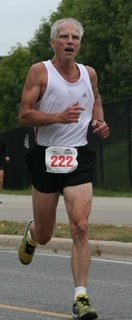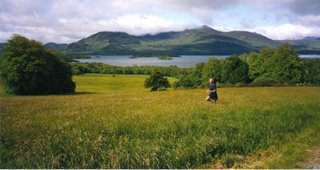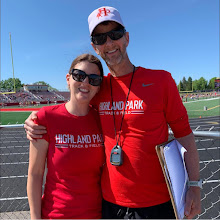 Compared to Don Wright, Jim Graupner started running early in life; he was 57. That was 5 years ago and in that short timeframe Jim has had more success than most runners even dream about in a lifetime. In his first year of running he finished second in the Runner of the Year (ROY) standings for his age group. That was just a precursor of things to come as Jim would go on to win ROY and the Grand Prix Series in each of the next 3 years.
Compared to Don Wright, Jim Graupner started running early in life; he was 57. That was 5 years ago and in that short timeframe Jim has had more success than most runners even dream about in a lifetime. In his first year of running he finished second in the Runner of the Year (ROY) standings for his age group. That was just a precursor of things to come as Jim would go on to win ROY and the Grand Prix Series in each of the next 3 years. My friend Eric introduced me to Jim in July of 2004 as we went for a nice 10-mile trail run. The next time I ran with Jim I wrote in my logbook “Quicker pace – thanks to Jim.” Little did I know this would become a recurring theme during our runs together. And little did I know that running would bridge our age gap and bring us together as friends. I could run for another 27 years and truly not meet a more kind, caring, competitive and humble person. When I grow up I want to be like Jim Graupner.
When did you start running? How’d you get involved?
Except for an attempt at running 10 miles at the 2001 Lumberjack Days, my first competitive race was the Northern Lakes 10-Miler on May 28, 2002. I met someone who said I ought to run the Manitou 15K the following week and I was hooked, running anything that came up. In the summer, I ran the Dick Beardsley Half Marathon and the following day, I ran a PR at the City of Lakes 25K. During the 25K runners were invited to throw their bib numbers in for a drawing for entry into the Twin Cities Marathon (TCM). Mine was the second number drawn, so I ran TCM a couple weeks later, and qualified for the Boston Marathon. That same summer, I met Frank Loy at the Mora Half Marathon; he encouraged me to go to Boston and provided me with his training schedules. Through that fall and winter I worked my way up to about 80 mpw, then tapered after the 2003 Human Race in March. So it began.
Did you run in HS/college? What other sports were you involved in?
Nothing organized: our little Wisconsin farm community didn’t have track or cross-country and, at 110 pounds, I wasn’t football material. In college, I competed in intramural gymnastics. I was an avid bicyclist, took some long trips; got into cross-country skiing—did a few Birkies; spent summers canoeing on the St. Croix; recently took up snowshoe running (managed division wins at Nationals the last two years and at the European Championships in Fondo, Italy, last January; also won the 2005 Midwest Championship Series); this spring I made my backpacking debut on the Lake Superior Trail and the Continental Divide Trail in Colorado.
What are your PRs?
Mile 5:31 Rice Street Mile 2003
5K 18:35 Monticello Riverfest 2004
8K 29:55 Human Race 2006
10K 38:18 Victory 2004
15K 1:00:22 Masters 2003
10 M 1:03:33 Lumberjack Days 2004
20K 1:22:55 Steven Fetzer 2004
HM 1:25:27 Urban Wildland 2004
25K 1:48:15 City of Lakes 2002
30K 2:10:10 Run Around Woman 2004
M 3:07:31 Grandma’s 2004
What’s your training philosophy?
Training is something new to me. Mostly, I’ve just tried to gain the endurance I needed for a marathon. Matt Haugen took me in with his Performance Power training group last year and Jeff Burkart at Lifetime Fitness is my core conditioning trainer. I read everything that comes my way and listen to advice from seasoned runners. John Naslund’s find-your-own-way-through-all-the-buzz has also made a lot of sense to me. Don Wright gave me Tim Noakes’ Lore of Running and I discovered Hal Higdon on the Internet. My philosophy is to run joyfully.
Have you had any injuries? Any tips to help recover or avoid them?
Until this year, I had no experience with injury or pain. During this year’s snowshoe season I struggled with minor feet discomforts. In May, following a backpacking trip, I began a seven-month bout with damaged muscles in the pelvic area. I mostly “ran through it,” until I realized that I was loosing ground on recovery efforts. Finally, after a painful Victory 10K, I stopped running completely and have thrown my energies into recovery.
Tips: Skip the denial stage and go directly to a medical doctor who has a competitive running background (both, for competent diagnosis and insight into obsessive behavior). Getting an accurate diagnosis and understanding of the injury are essential. Learn everything you can about your specific injury, both anatomically and physiologically. Learn how the various systems of the body relate to each other and how the body compensates and heals. Follow the diagnosis with appropriate treatment and aggressive therapy. Give yourself time to fully recover.
Do you ever take a day off? How about training cycles and downtime at the end of the season?
Especially as a runner ages, recovery time increases so I usually take a day off per week and follow the hard/easy plan. I’ve found that a lot can be done with strategic workouts, but lower mileage. Core conditioning is a constant. Transitioning into a new season is important; even though it’s difficult to change the routine, you’ve actually convinced me to switch from build to base development during the winter. My training interest becomes more hills and race-specific in the spring.
Are there certain plans (Pfitz, Daniels, etc) that you tend to follow?
I garner ideas that seem to have a good foundation; I’m not orthodox about programming.
How do you decide which races to run? How many races do you run a year?
Whether they are certified, part of the Minnesota Distance Running Association’s (MDRA) Grand Prix Series, and provide a balance of opportunities at all the major distances. Until this year, I ran one or sometimes two races every week. Racing is often just a form of training.
What do you look for in a race? Do you have any advice for race directors?
Good field of runners; well-designed routes; competent management; sufficient facilities to take care of human needs, timely results that are submitted to the Minnesota Running Data Center (MRDC) to be used for the Runner of the Year standings; and great community support. I especially enjoy races that have a great diversity of runners and opportunities for children’s runs. I like the trend towards having t-shirts optional, especially when there is advertising on them. Results ceremonies should be efficient and build up to the overall winners; winners of the divisions should be submitted to media and reasonably complete results should be reported in runners’ magazines.
Do you have a favorite local race?
Lumberjack Days 10-Miler is always fun, even though often hot and muggy
What’s your favorite place to run?
The Tri-Lakes region in Lake Elmo is my favorite because there’s a nice balance of terrain and it’s expandable. I also love the Mississippi River Road and the Scandia/Marine countryside.
Do you have a favorite workout or something you use as a benchmark?
The half marathon distance works well as a gauge.
Who do you enjoy training with the most?
I’m a lone wolf for the most part, but I’ve particularly looked forward to running with Don Wright, whose attitude always improves the day. I’ve benefited a great deal from training with Matt Haugen’s running group out of Macalester.
If you could run with anyone (past or present), who would it be? Heroes?
Racing gives me the opportunity to run with and learn from the athletes I admire most. There are at least a hundred heroes of mine running most weekends, men and women.
Any runner (or other athlete) you’d like to change places with for a day?
Any 20 year old athlete.
Who is the toughest runner you have ever run head-to-head against?
Hehe, that’s a toss up among Dan Conway, Jared Mondry and Norm Purrington. But, there are also specters from the record books: namely, Alex Ratelle and Thom Weddle. It’s a real kick occupying, if only temporarily, one of the spots on the 8K top-ten all-time 60-64 age-group-list this year.
What’s your fondest running memory?
Running while traveling abroad: Ireland, Eastern Europe, China, Brazil and the Italian Alps.
How has your training and racing gone this year?
I enjoyed training and a few good races, including the Human Race 8K, where I managed a 29:55 PR. Injuries compromised most of the season, unfortunately.
What are your interests outside of running?
Almost any physical activity that takes me into nature. My family. Writing. Travel.
What do you take away from your first five years of running?
Running and other outside activities has become my central framework in retirement. It’s been instrumental in helping me deal with the many transitions that have taken place in the last five years. It’s helped me physically, mentally, and spiritually.
I fully understand that running success is a product of health and desire and that the symbols of that success are ephemeral by the very nature of competition. Running awakens me to myself and to the inspirational courage with which other people bring to their personal challenges everyday.
Minnesota has a truly amazing running culture which is supported by the MDRA, informed by Raceberry Jam and excellent running organizations and enterprises, committed to the record books by Jack Moran and the MRDC, and encouraged by an enlightened running community.

Jim in Ireland

3 comments:
Chad,
Great story on Jim. He is an incredible runner and friend. A better person would be hard to find.
Chad,
I echo your comments about Jim's grit: "Quicker pace – thanks to Jim.” As a triathlete, I've only had a couple P2 sessions to run with Jim. But the goal is always to try and keep up!
You couldn't find a nicer person to run with. His injury perspective is also quite insightful.
In the Snowshoe Race season of
2008, Jim Graupner was the single snowshoer who participated in the most United States Snowshoe Association qualifiers throughout the country. . . A noteworthy achievement.
He also was a factor in each of those events, probably entering 7 of the possible 21 races scattered throughtout the U.S. snowbelt. Winning his class in each race and always at the front in the overall results, he also won the 2008 USSSA National Snowshoe Championship for his category, at an altitude location, for the upmteenth time.
Very eloquent in his remarks, I quoted him extensively in the Snowshoe Magazine coverage about that Utah National Championship race.
The link is:
http://www.snowshoemag.com/view_content.cfm?content_id=396
Whenever I found him at one of the Qualifiers, I worked to get his comments included in any written coverage. He has a wonderful command of the language in addition to his command of the trails, whether or not snow covered.
Phillip Gary Smith
www.ultrasuperior.com
Post a Comment